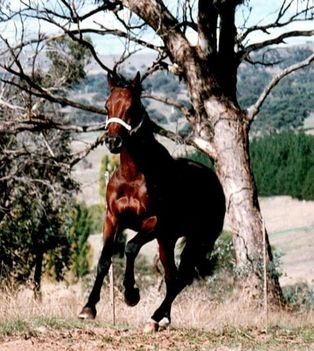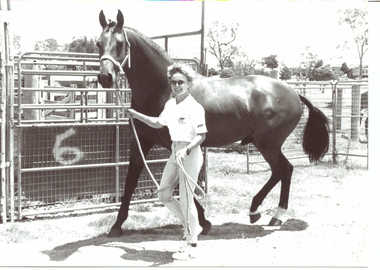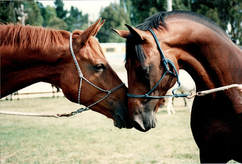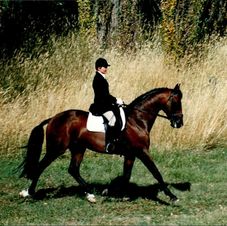|
This original article by Joanne Verikios was first published in Equestrian Country Magazine, Issue 2, Autumn 2017 (Photographs below are from author's collection)  Warmblood Stallion Highborn Powerlifter enjoyed the freedom of his paddock Warmblood Stallion Highborn Powerlifter enjoyed the freedom of his paddock Behold the stallion. No matter what breed or size, stallions draw us in with their presence and intrigue us with their drive and ambition. Anybody who has been around horses for a while has a stallion story, whether it’s an inspiring tale of gentleness and manners or a horror story of horsepower gone wrong. The gentle art of stallion management and training, from colt foal to full-grown, is usually what makes the difference, both to the stallion’s life and that of the humans who come into contact with him. This is, of course, true for all horses, but stallions are perhaps the most sensitive to poor handling practices, especially when their agenda differs from their owner’s agenda in a big way. First of all, let’s take a look at what makes a stallion tick.  "Love on Legs"! Joanne Verikios with Highborn Powerlifter, the Warmblood stallion she bred and trained "Love on Legs"! Joanne Verikios with Highborn Powerlifter, the Warmblood stallion she bred and trained Stallions are intensely social animals. They exist to sire foals. In order to fulfil his genetic potential in the most efficient and effective way in the wild, a stallion will collect and protect a band of mares. This includes adding new mares as the opportunity arises and seeing off rivals through posturing or full-on fighting, depending on the age and determination of the challenger. Colts rehearse the skills that Mother Nature has programmed them to need through regular (and rough) horseplay with other colts. They also learn manners with regard to the opposite sex through warnings and stern rebukes from mares (with the exception, perhaps, of their long-suffering and usually very tolerant mothers). In a totally natural situation, humans have no role whatsoever. But that is in the wild. While there are domestic horses that grow up in a herd situation, in many cases it is common for colts to either be gelded or, if kept entire, to be separated from mares and fillies at a relatively early age (around nine months is a good time to segregate the sexes in order to avoid in-breeding and other unwanted pregnancies). Unless they are able to run with older horses like geldings or in-foal mares, these colts can miss important equine socialisation experiences, including the important lesson that not everyone they meet wants them to father their babies! Handlers of colts and stallions must therefore be able to compensate for this through a combination of skills, tact and fairness. Stallions are not for beginners! If you have to ask for advice on what to do or when to do it, you are not ready.  Full brothers share a moment. Gelding H. Istvan (L) and Stallion H. Powerlifter (R) Full brothers share a moment. Gelding H. Istvan (L) and Stallion H. Powerlifter (R) In the interests of the safety and sanity of all concerned, I cannot emphasise strongly enough that stallions are not for beginners! As a rule of thumb, if you have to ask for advice on what to do or when to do it, you are not ready. A stallion is fundamentally a breeding machine. Unless you can earn his trust and respect, unless you can train him to yield willingly to you, unless you are able to control him by working with his mind rather than attempting to restrain his body, you are placing yourself and others in danger. Yes, there are exceptions. There are very quiet stallions. There are stallions with lower libidos than others. But just as the wrong rider can undo years of schooling, the wrong handler can undo years of training. Any horse can react faster than the human eye can follow and if you are in the wrong place at the wrong time, you can be hurt or killed. This applies irrespective of your relationship with a horse. His hooves can be on the way before he has even registered you are there. Don’t take the risk. If your horse’s behaviour – mare, gelding or stallion – frightens you or is proving beyond your ability to modify, then GET HELP URGENTLY, before someone gets hurt and/or your horse learns aversive actions that will be difficult to erase. A well-behaved horse has a much better chance of a long and happy life than a problem horse, so you owe it to your stallion to forge and maintain a great working relationship. The key concept to a successful partnership with a stallion is teamwork. Teamwork is a lot easier to achieve if you understand both your stallion’s mind and his hormones. Stallions have beautiful minds. They also tend to have rather compelling hormones! In working with our stallion, we need to help him to learn to compartmentalise: to understand and to accept what behaviour is appropriate under what circumstances. How can we do this? Every situation is different, so your challenge is to come up with ideas that will work for you. Routine is your friend. Think about the things you need your stallion to do and consider how you can keep the breeding side of his life separate from his other roles, such as being a riding horse. The essence of routine is consistency and consistency leads to habits. This can be very basic, but you must concentrate on maintaining consistency or you may give your stallion an opportunity to learn bad habits. Here are some recommendations for things you can do or focus on in order to establish good habits. Make it easy for your stallion to know when he is off duty by having different tack for different roles. Unless he is running with mares all the time, your stallion should learn that he wears a certain halter or bridle for his stud work from the ones he wears for everyday leading, lunging, riding or driving. Every single time. Another rule he will quickly learn, whether he is a paddock stallion or serves in hand, is that breeding is off limits when he is wearing a saddle and/or being ridden. Make it easy for your stallion to know when he is off duty by having different tack for different roles.  The author riding Highborn Powerlifter (photo by Jeanne O'Malley) The author riding Highborn Powerlifter (photo by Jeanne O'Malley) Similarly, have different locations for his different roles. Try to have one place where your stallion serves mares or is collected for A.I. Make sure that that place is not used for anything else as far as he is concerned. For example, if you hand serve with your horse, never feed him, groom him, shoe him, medicate him or ride him in the breeding area. Understand that YOU must make all the decisions when you’re together with your stallion. When he moves, where he goes, when he stops – it’s all up to you to call the shots. This means that you have to be alert and consistent 100% of the time. It’s simple and effective, but that doesn’t mean it’s easy. Stallions like to play little mind games. They love to watch you draw a line in the sand and then see how far they can go in crossing that line – or rubbing it out altogether! Especially when your horse is young, be prepared to draw that line over and over and over again, and always in the same place. You will need patience to keep drawing the line and to hold the line without letting negative emotions get the better of you. For example, it’s natural, from the stallion’s point of view, to nibble, nip and bite. It’s part of foreplay and it has a role in battle too. Some people will allow a nibble (which doesn’t hurt them) but will react angrily to a bite (which hurts or worse). That is an inconsistent response to the horse testing the boundaries. Anger and fear have no place in horsemanship. As Adele von Rust McCormick tells us, “Horses have taught us about the transfiguring effect of reducing anger. We have repeatedly observed that they rarely show offense at a handler who reprimands them legitimately for something they have done wrong, if the handler is devoid of rage or vengeance. However, if reprimanded in a fury, horses will counterattack because they feel challenged. Many power struggles can be avoided by learning not to meet anger with anger. This is an invaluable lesson in life. Developing patience and being unemotional is the key.” Make some sensible rules for your relationship with your stallion, and stick to them. With stallions, there are no grey areas – it is always black and white. For instance, you will insist that he wait for your cue before doing anything, including serving mares. Even then, he should proceed under control and stop if you ask him to stop. You will also insist that he respects your personal space unless you invite him in. Another rule is that, once he has accepted you as not being a threat, you may enter his personal space. Both of you must be polite about it. The last rule is not to have too many rules or you will both get confused! Treat your stallion like any other horse as far as possible – but never forget that he is a stallion. He will be so much happier if he has room to move and can see and communicate with other horses at home. Feed him according to the work he is doing and give him plenty of exercise to keep him fit and utilise his energy in a constructive way. "Work with your stallion's mind, rather than against his muscles." ~ Joanne Verikios It is your responsibility to keep him safe. This includes making sure that all his fences and gates are high enough and strong enough, and that his stable is secure and free from gaps or partitions that might trap a head or a leg or a hoof. Stallions can get very active in their stables and yards, which should be big enough for rearing, bucking and spinning! Electric paddock fences can work well but they too should be high enough to discourage jumping out or hooking forelegs over the top. Another element of safety is watching out for him and for others when you are out and about. Not everybody is tuned in to the needs and wants of stallions and they will sometimes allow their horses, children and vehicles to come rather too close for comfort.
In conclusion, patient, persistent, kind and confident training that works with your stallion’s mind, rather than against his muscles, will cement your partnership. Success, as they say, happens at the speed of learning. Feel free to contact the author here or contribute by commenting below. Comments are closed.
|
From a very early age I have been able to tune in to what horses and ponies were thinking and what they were likely to do next.
Archives
September 2020
Categories
All
|


 RSS Feed
RSS Feed